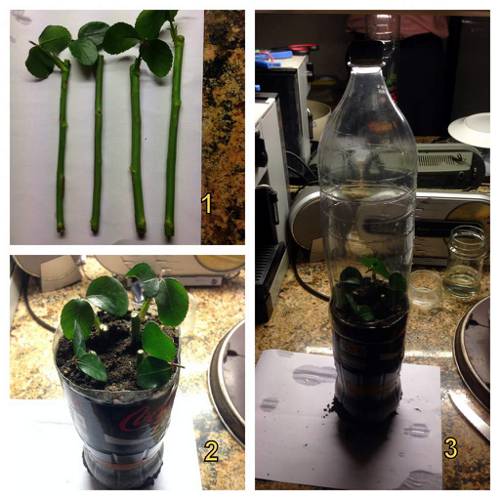
FAQ About Indoor Plant Propagation from Cuttings

What is plant propagation by cuttings?
Plant propagation by cuttings is a method of producing new plants from a part of an existing plant, such as a stem, leaf, or root. This technique allows gardeners to create new plants that are exact clones of the original, ensuring the same characteristics such as flower color and leaf pattern are retained.

Which indoor plants are easy to propagate from cuttings?
Some of the easiest indoor plants to propagate from cuttings include pothos, spider plants, African violets, succulents like jade plant and kalanchoe, and herbs like mint and basil. These plants typically root readily in water or soil, making them ideal for beginners.

What are the basic steps for propagating plants from stem cuttings?
The basic steps for propagating plants from stem cuttings include: 1) Select a healthy parent plant. 2) Take cuttings about 4-6 inches long, with at least two sets of leaves. 3) Remove the leaves from the bottom half of the cutting. 4) Optionally dip the cut end in rooting hormone to encourage growth. 5) Place the cutting in water or a moist potting mix. 6) Keep the cutting in a warm, bright, but not direct sunlight environment. 7) Wait for roots to develop before transplanting.

How can I propagate a plant from a leaf cutting?
To propagate a plant from a leaf cutting, gently remove a healthy leaf from the parent plant, ensuring that you include a small part of the stem (petiole). For plants such as succulents, allow the leaf to dry for a day to form a callus. Then, place the leaf on the surface of a well-draining soil mix or in water if applicable. Keep the soil slightly moist and wait patiently for roots and new growth to emerge, which may take several weeks.

What role does rooting hormone play in plant propagation?
Rooting hormone, which is often available in powder, liquid, or gel form, helps stimulate root growth on cuttings. It contains synthetic auxins, which are plant hormones that encourage rooting. While not always necessary, especially for easy-to-root plants, the use of rooting hormone can increase success rates and speed up rooting for more challenging species.

Can all plants be propagated from cuttings?
Not all plants can be effectively propagated from cuttings. While many herbaceous plants and some woody plants can be, others may require alternative methods such as seed propagation, division, or air layering. It's important to research the specific propagation requirements of each plant species.

What are common mistakes to avoid when propagating from cuttings?
Common mistakes include taking cuttings that are too large or too small, using dull tools which can damage the cutting, not keeping the cuttings in a warm and humid environment, overwatering or underwatering, and not using sterile equipment which can introduce diseases. Ensuring proper technique and care can improve your success rate.

How long does it typically take for roots to develop in cuttings?
The time it takes for cuttings to root can vary greatly depending on the plant species and environmental conditions. Generally, you can expect root development to start within 2 to 4 weeks. However, some plants may take longer, sometimes even several months.

Should cuttings be placed in water or soil for rooting?
Both methods can be effective. Placing cuttings in water allows you to easily monitor root development and is ideal for plants like pothos or philodendron. For others, especially woody cuttings, planting directly in soil may be preferable as it promotes stronger root systems geared for soil environments. The choice can also depend on the plant species and personal preference.

What is the best time of year to take cuttings for indoor plants?
Spring and summer are generally the best times to take cuttings since plants are in their active growth phase, which encourages stronger and faster root development. However, indoor conditions can be managed to take cuttings year-round, provided the right temperature, light, and humidity levels are maintained.

How do you propagate succulents from cuttings?
To propagate succulents from cuttings, choose a healthy leaf or stem, let it dry for a day or two to form a callus, and then place it on well-draining soil. Mist lightly every few days and place in bright but indirect light. Roots and new growth should appear within a few weeks.

What is the importance of humidity in propagating cuttings?
Humidity is crucial for successful propagation because it prevents the cuttings from drying out and aids in maintaining moisture levels necessary for root development. Using a humidity dome or plastic bag can help retain the moisture around the cuttings, creating an ideal micro-environment for rooting.

How do you care for cuttings once they start developing roots?
Once cuttings develop roots, gradually acclimate them to their new environment by reducing humidity and water levels slightly. Transition them to a more permanent pot with appropriate potting mix. Ensure they receive adequate light and are not exposed to temperature extremes to promote healthy growth.

Can I use tap water for rooting my cuttings?
Tap water can generally be used for rooting cuttings, but it’s important to let it sit for 24 hours to allow chlorine to evaporate, as chlorine can inhibit root growth. Alternatively, using distilled or rainwater can avoid this issue entirely, ensuring optimal conditions for rooting.

What are some signs that a cutting is not successful?
Signs that a cutting may not be successful include wilting, yellowing, or browning of leaves, lack of new root growth after a few weeks, and a mushy or dying appearance. These issues might arise from overwatering, under-sterilization of tools, or unsuitable environmental conditions.

How do you propagate a spider plant from its babies or offsets?
Spider plants produce babies or offsets that can be easily propagated. To propagate, snip the baby from the mother plant and place it in water or directly into soil. If planting in soil, ensure it’s well-draining. Keep the baby in a warm, bright location and water lightly until it establishes roots.

Do you need to sterilize tools before taking plant cuttings?
Yes, sterilizing tools is essential to prevent the transfer of diseases and pathogens between plants. Using a solution of rubbing alcohol or a diluted bleach solution can effectively disinfect your pruning shears or knives before taking cuttings.

How do I know if my indoor cutting needs to be transferred from water to soil?
When roots are approximately 1 to 2 inches long and have developed a fair number of rootlets, it is typically time to transfer the cutting from water to soil. Ensure the soil is well-draining and continue to monitor watering needs closely during the transition phase.

Is it necessary to use special containers for propagating cuttings?
While not strictly necessary, using small containers like propagation trays, pots with drainage holes, or clear containers can be beneficial. These aid in managing humidity and preventing waterlogging, which is crucial for successful rooting. Additionally, clear containers allow you to monitor root growth more easily.

What is the difference between softwood, semi-hardwood, and hardwood cuttings?
Softwood cuttings are taken from the soft, new growth of a plant and root quickly, often found in spring. Semi-hardwood cuttings are partially mature and typically taken in summer, providing a balance between rapid rooting and strength. Hardwood cuttings are mature and woody, taken in fall or early winter, and may take longer to root but provide strong plants once established.
